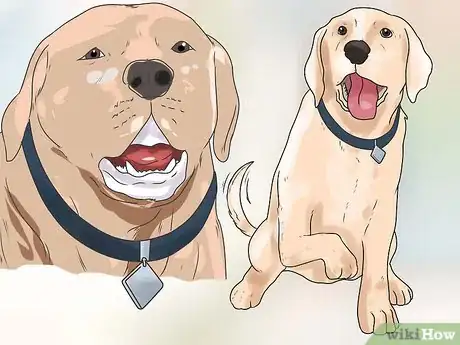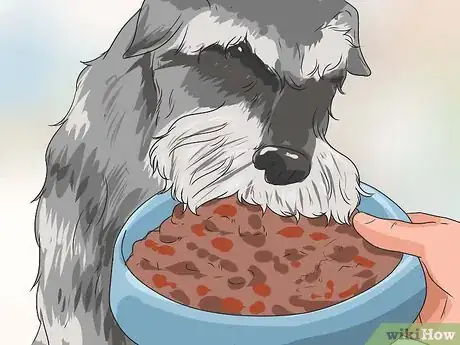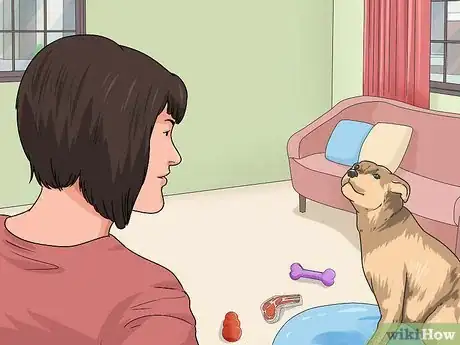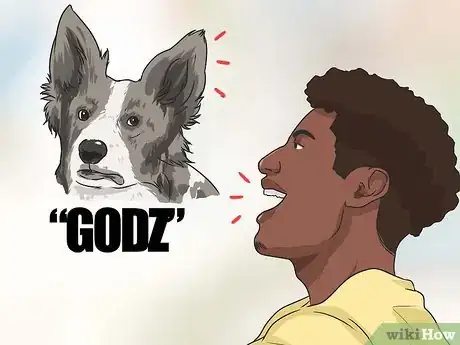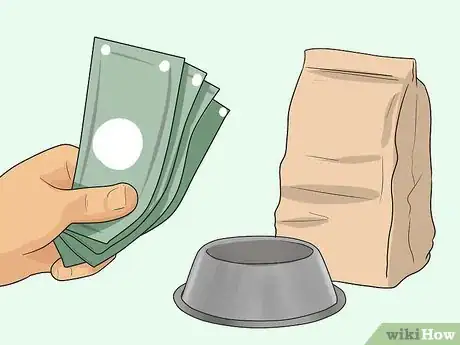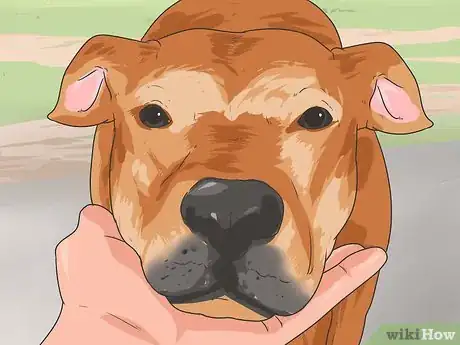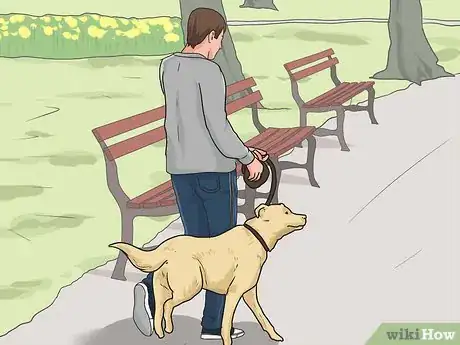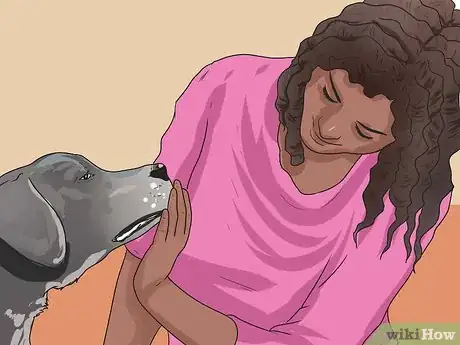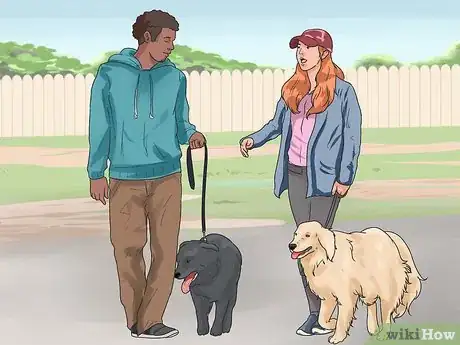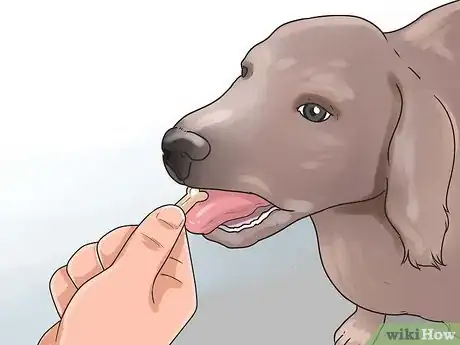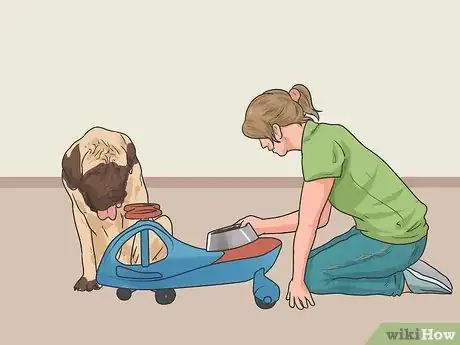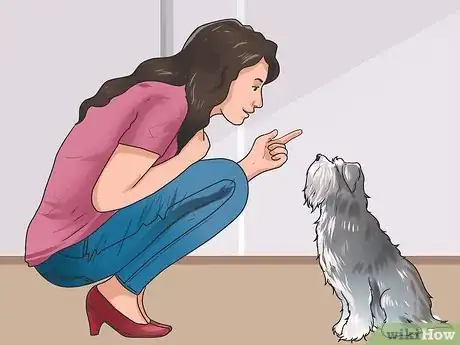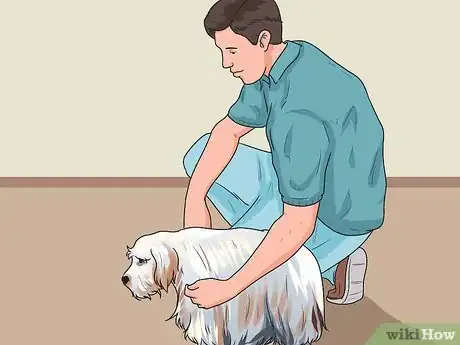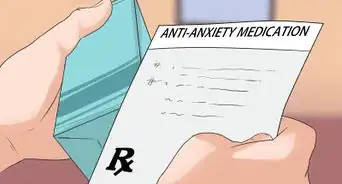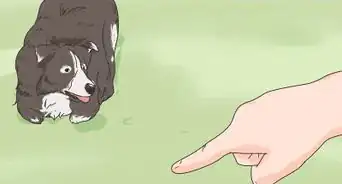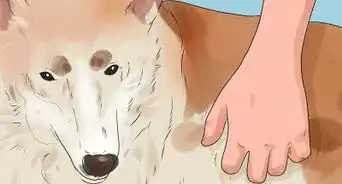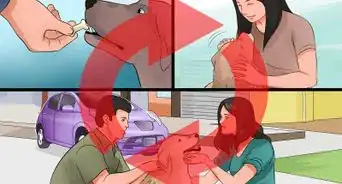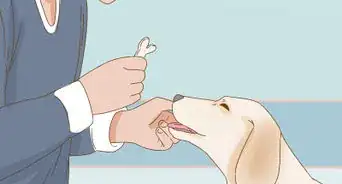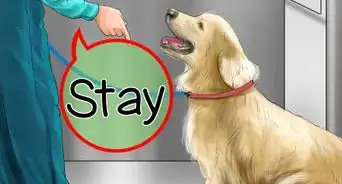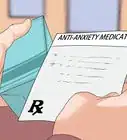This article was co-authored by Beverly Ulbrich. Beverly Ulbrich is a Dog Behaviorist and Trainer and the Founder of The Pooch Coach, a private dog training business based in the San Francisco Bay Area. She is a Certified CGC (Canine Good Citizen) Evaluator by the American Kennel Club and has served on the Board of Directors for the American Humane Association and Rocket Dog Rescue. She has been voted the best private dog trainer in the San Francisco Bay Area 4 times by SF Chronicle and by Bay Woof, and she has won 4 "Top Dog Blog" awards. She has also been featured on TV as a dog behavior expert. Beverly has over 18 years of dog behavior training experience and specializes in dog aggression and anxiety training. She has a Master of Business Administration from Santa Clara University and a BS from Rutgers University.
There are 8 references cited in this article, which can be found at the bottom of the page.
wikiHow marks an article as reader-approved once it receives enough positive feedback. In this case, 85% of readers who voted found the article helpful, earning it our reader-approved status.
This article has been viewed 119,130 times.
Animals are abused by humans every day and this abuse can leave lifelong physical and emotional scars on the animals that survive it.[1] Animals that have been abused need help to get out of those situations but they also need new homes to go to once they are rescued.[2] If you are looking to adopt a pet and you have a lot of time to give it, consider adopting one that has survived abuse. You will need a lot of patience and to give a lot of care, but building up trust with an abused dog can be a life-changing experience for you and the animal.
Steps
Fulfilling the Dog's Basic Needs
-
1Make sure your dog has identification on it. Give your dog a collar with a name tag and your number on it. Make sure it fits comfortably on your dog's neck. An abused dog may get spooked or escape from you, and you want to make sure that if it does get away from you it can be identified.
-
2Feed the dog. Give it its favorite food at regular times during the day.[3] It is recommended that a dog be fed twice a day.[4]
- You should also give your dog open access to water at all times.
- Feeding, walks, play, and grooming should all happen at predictable times each day because having a routine will build a sense of security for your dog.
Advertisement -
3Give the dog a space of its own. This is usually a crate or a bed that the dog feels comfortable on. There are a wide variety of dog pillows and baskets in pet shops that you can buy for it.
- The dog's space should serve as a place where it can take a break. If your dog is feeling overwhelmed or fearful, make sure to allow the dog to return to its safe space and leave it alone.
- You can also give the dog some toys to play with on its own. Most dogs won't like every toy you give them, but instead will choose a favorite and ignore others completely.
-
4Give the dog a name and teach it to respond to it. Always call your dog by its name and try not to change it. Changing names will just confuse the dog.
- Having a name that your dog will respond to will keep help you to bond with the dog. Use a happy and upbeat tone of voice when you call the dog by name. This will help to build good will between you and the dog.
-
5Buy treats you can use to train the dog. Try lots of different treats until you find its favorite. Give it snacks when it's good, follows a command, or does a trick.
Showing the Dog Love
-
1Pet the dog delicately. Many dog who have been abused are hand shy, meaning that they are fearful when approached by hands.[5] Pet your dog with your palm up under his or her head, not over the head or on the dog's rear end. It isn't an offensive motion if you use the palm up.
- You want to make sure that the dog sees you coming before you pet it. While you might get closer to a fearful dog by sneaking up on it, you will not build trust that way and you might get bitten due to fear.
-
2Exercise and play with the dog. You need to build up trust with an abused dog, so once again you need to be delicate with your play at first. After about a month, your dog should start to trust you. Play football, catch, races, and anything else your dog enjoys doing.
- The more walks you give it, the more trust you get.
-
3Give the dog plenty of attention but don't smother it.[6] You need to walk the line between giving the dog attention and giving the dog freedom. Keep a bit of time every day to play with your dog. However, your attention can be stressful to a dog that is distrustful of you. Give it a break from your attention if it becomes too much for the dog.
-
4Socialize the dog cautiously. Your dog needs to build trust with other people and dogs, in addition to you. This can be difficult to achieve if the dog has been severely abused. Begin slowly, by letting the dog see other dogs or people at a distance. Then very gradually let your dog get closer. You will probably want to get a volunteer to be the stranger you introduce your dog to, as you don't want to scare a stranger with a possibly aggressive dog.
- Once you and your dogs are nearly soul mates you might want to take getting another dog into consideration. If you cannot handle it, simply take the dog out for more walks so it can meet other dogs.
- Dogs that have not been properly socialized, but have not been abused, can appear as if they have been abused.[7] Socialize any dog that has socialization issues, as it can even help dogs that have not been abused.
Training the Dog
-
1Use rewards instead of punishment. You want to reinforce positive behavior instead of punishment because most dogs understand the connection between actions and rewards more clearly than what they are being punished for.
- Never hit a dog. If you don't like something the dog is doing a simple and calm "no" or Uh-uh will usually suffice.
-
2Use counter conditioning.[8] Counter conditioning will be helpful if your dog has specific fears. It works by conditioning the dog to get closer and closer to things it fears by luring it close with something it loves.
- For example, if your dog is afraid of bicycles, you place your dogs favorite toy or a treat close to a bicycle. After the dog takes the bait, you gradually (over days or weeks) move the treat or toy closer to the feared item.
-
3Train your dog in basic commands. This may go slowly if you have just adopted an abused dog. Just remember that if you build enough trust between you and the dog, it will eventually want to follow your command.
- Begin with "sit" and "come" commands. These will set the foundation for further training, such as "heel," "lay," and a wide variety of others.
-
4Be patient. An abused dog has gone through a lot of trauma and deserves some time and patience from you. It's fine to have some behavior expectations but don't be unrealistic. The dog doesn't have any reason to trust you, as they may have had strictly bad relationships with humans. Give your pup some time and show it every day that your are trustworthy.
Expert Q&A
Did you know you can get expert answers for this article?
Unlock expert answers by supporting wikiHow
-
QuestionHow do I get my dog to like me more?
 Beverly UlbrichBeverly Ulbrich is a Dog Behaviorist and Trainer and the Founder of The Pooch Coach, a private dog training business based in the San Francisco Bay Area. She is a Certified CGC (Canine Good Citizen) Evaluator by the American Kennel Club and has served on the Board of Directors for the American Humane Association and Rocket Dog Rescue. She has been voted the best private dog trainer in the San Francisco Bay Area 4 times by SF Chronicle and by Bay Woof, and she has won 4 "Top Dog Blog" awards. She has also been featured on TV as a dog behavior expert. Beverly has over 18 years of dog behavior training experience and specializes in dog aggression and anxiety training. She has a Master of Business Administration from Santa Clara University and a BS from Rutgers University.
Beverly UlbrichBeverly Ulbrich is a Dog Behaviorist and Trainer and the Founder of The Pooch Coach, a private dog training business based in the San Francisco Bay Area. She is a Certified CGC (Canine Good Citizen) Evaluator by the American Kennel Club and has served on the Board of Directors for the American Humane Association and Rocket Dog Rescue. She has been voted the best private dog trainer in the San Francisco Bay Area 4 times by SF Chronicle and by Bay Woof, and she has won 4 "Top Dog Blog" awards. She has also been featured on TV as a dog behavior expert. Beverly has over 18 years of dog behavior training experience and specializes in dog aggression and anxiety training. She has a Master of Business Administration from Santa Clara University and a BS from Rutgers University.
Dog Behaviorist & Trainer
-
QuestionHow can I help my dog to not flinch every time I move?
 Community AnswerCall the dog before you move, so it's attention is on you first. Make slow gradual movements, and over time this should help.
Community AnswerCall the dog before you move, so it's attention is on you first. Make slow gradual movements, and over time this should help. -
QuestionHow do I potty train my puppy if she's been abused so severely that she refuses to go outside?
 Community AnswerPee pads can be bought at most stores, and using a pee pad is a better option than forcing the dog to go outside. Put the pad in a safe location and leave it there until the dog uses it. After the dog uses the pad, a treat and soft praises will help enforce the behavior. Give this about two weeks, then move the pad a bit closer to the door where you will take them outside. Eventually you will be able to set the pad just outside of the door and hopefully your dog will feel more comfortable going outside.
Community AnswerPee pads can be bought at most stores, and using a pee pad is a better option than forcing the dog to go outside. Put the pad in a safe location and leave it there until the dog uses it. After the dog uses the pad, a treat and soft praises will help enforce the behavior. Give this about two weeks, then move the pad a bit closer to the door where you will take them outside. Eventually you will be able to set the pad just outside of the door and hopefully your dog will feel more comfortable going outside.
Warnings
- Don't give the dog too much freedom at first because it might run away if it gets spooked or is fearful of you.⧼thumbs_response⧽
- Don't let the dog get away with everything. Make sure it follows your rules. You may want the dog to like you but it will like you more in the long run if you set some boundaries. While you can't expect the dog to behave perfectly right off the bat, you can expect it to not tear up your house or injure anyone.⧼thumbs_response⧽
References
- ↑ http://www.humanesociety.org/issues/abuse_neglect/qa/cruelty_faq.html?credit=web_id91919525
- ↑ http://www.humanesociety.org/issues/abuse_neglect/tips/cruelty_action.html
- ↑ Beverly Ulbrich. Dog Behaviorist & Trainer. Expert Interview. 30 January 2020.
- ↑ https://www.aspca.org/pet-care/dog-care/feeding-your-adult-dog
- ↑ https://www.aspca.org/pet-care/virtual-pet-behaviorist/dog-behavior/dogs-who-are-hand-shy
- ↑ Beverly Ulbrich. Dog Behaviorist & Trainer. Expert Interview. 30 January 2020.
- ↑ http://www.veterinarypartner.com/Content.plx?A=1751
- ↑ http://www.goodhousekeeping.com/life/pets/q-and-a/a21152/gaining-trust-of-abused-dog/
- ↑ http://nypost.com/2015/01/26/aspca-working-on-new-compstat-but-for-animal-abusers/
About This Article
To gain the trust of an abused dog, make sure it sees you coming before you try to pet it. Then, pet it gently under its chin with your palm facing up. You should also take it for walks twice a day to help the dog get used to you. Additionally, use positive reinforcement to strengthen good behavior, such as giving it a treat, rather than punishing it for bad behavior. For tips on how to socialize and train your dog, read on!
